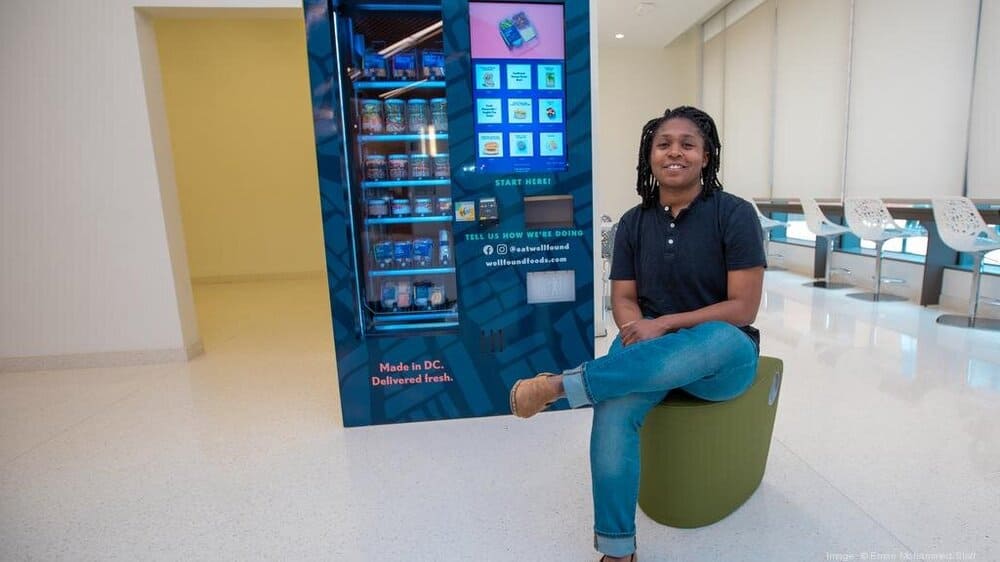How can you better scale team responsibilities to shepherd your company to the next level?
This age-old question doesn’t exist within a silo. Leaders tend to hold the most in-depth knowledge of the vital processes that make their operations turn (or not). Often, though, that knowledge isn’t shared effectively between more than a select few team members, which creates knowledge gaps for the rest of the team. In effect, these gaps become individualized problems that should be shared to determine solutions company-wide.
To counter this, leaders must communicate the “how” and “why” so they can unify their teams, scale ownership, and solve problems efficiently.
Equipping employees with the minutiae to meet the demands of a purpose-driven growing company is what makes Wellfound Foods, a wholesale grab-and-go food company with a mission to deliver quality on-the-go, tick.
I recently interviewed Wellfound’s Founder/CEO Sarah Frimpong, D.C. native, graduate of Mount Holyoke College, to hear what she has to say on the importance of identifying knowledge gaps within teams, and how to traverse them to meet common goals.
Building Mental Models to Unify Teams, with Wellfound Foods Founder & CEO Sarah Frimpong from Chase Damiano on Vimeo.
Sarah Frimpong: My name is Sarah Frimpong. My company is Wellfound Foods and we make fresh grab-and-go food that’s available to our customers via wholesale. We work with different coffee shops in the area and supply them with wholesale packaged sandwiches and salads. We also sell the same products that we make in our commissary through our Smart Markets, which are essentially tech-enabled vending machines. Our team is 10 people strong and we’re based in DC.
Chase Damiano: You’ve had these vending machines for a bit, and I’ve had the pleasure of seeing these live and in action and they’re pretty awesome.
SF: Appreciate that. Yeah. It’s funny. The first one went in in ’19 and then the lost year of 2020 happened. It does still feel like a pretty new business line.
CD: Yeah. Rock on. And why did you start Wellfound Foods? What were you trying to achieve?
SF: I started Wellfound because I felt that packaged food, grab-and-go food, could just be better. At the time, I was working at a cafe where we were sourcing packaged grab-and-go product that was super inconsistently made, didn’t have a lot of care put into the product, and I just thought: “It doesn’t need to be this way.” Something could be better and this does provide a lot of utility to people, this kind of pre-packaged food. And so, we kind of started on that path. Selling to cafes made a lot of sense because that’s where I confronted the problem. But then, it became clear there are a lot of different applications for getting better grab-and-go food to people.
CD: Yeah, that makes a lot of sense. Just the ability to go out and pick something that’s fresh, healthy, and good for me is still rare these days. I love your solution, as a longtime Wellfound customer myself. I was always opening up sandwiches and just going to town. It was a great alternative to waiting in line at a restaurant or going to get fast-casual to just be, like, “I need something right now.”
SF: Yep. Yep.
CD: I’d love to talk a little bit about a learning that you’ve had that really shifted your perspective on how you operate as a leader. With Wellfound Foods, you’ve been in business for a number of years now and you’ve had your own narrative and your own arc in terms of how the company flourished. How has it come about? And so, I’m interested in hearing: What’s something that you learned during this journey so far?
SF: Great question—Lots of learnings. You get new ones every day. I think the biggest one as a leader has really been trusting your team members to do the things that you need them to do. It’s funny because the challenge that we talk about is scaling that out. But the biggest learning has been that you can’t do everything. You need a team to rely on to do certain things, and what you need from your team changes as you grow. That’s been the biggest thing for me.
CD: Yeah. It’s big. Especially, if you get to a certain size, it’s really hard to do everything solo. You almost need to be able to scale execution across an ever-increasing team as the opportunity size that you’re trying to capture becomes more clear. I’d love to explore. What’s a challenge that you’re facing in your business today?
SF: The thing that I’ve learned: You need a team that you can rely on to be able to carry forward and through on these tasks. But also, at the stage Wellfound is in right now, the demands on that team are growing. I think even when I had and still have a team that I could trust, I still had my hand in everything. I was really helping shepherd everything along. And I was really involved in solving the problem that each individual was facing within the company.
But I’m now recognizing I can’t do that. We have so many more, I don’t even want to say people, but so many more responsibilities because of the opportunity that we’re chasing with vending. We’re now a tech company. It’s food and it’s technology. And so, there’s just so much more that has to be tackled. The challenge I’m facing is kind of scaling the responsibility and the ownership of problems because they’re all with me right now. But I need other people to, as you kind of put it, feel the pain of the problem so that they can really help solve it. And I’m struggling to be able to communicate that so we can actually create solutions at different levels of the company if that makes sense.
CD: It makes perfect sense. You’re trying to bring about more ownership and responsibility across the greater team, especially now as you’re moving from food into tech plus food, and how all that’s going to work out.
SF: That’s right.
CD: Surely, the amount of uncertainty that is happening within the business is also starting to shift. Tell me about the result that you’re looking for. Were this challenge to be fully solved, what would the world look like?
SF: I think if this challenge were fully solved, the problem would look like me better communicating challenges to everybody on the team. And then, perhaps having individual conversations with each person or each department about maybe some of the minutiae of that challenge in their world, but then having them take that problem and create solutions. And I’m sure I’m still going to be involved in figuring out if this is the best solution that we move forward with. But, in a perfect world, I think I’m better able to express what we’re facing and giving people the tools to solve those problems themselves. That way, they’re owning it and they’re moving forward with it more than me saying, “Oh man, this is a big problem that we have to solve. Hey, this person, can you do X, Y, and Z following process A, B and C. Let me know how that goes. All right. Let’s iterate again.” I want them to really own that whole part.
CD: Yeah. That makes sense. You want to see a world where you’re able to better communicate some of these challenges or problems, and then to be able to have a certain number of conversations with each person or department or team. You want to have them take the problem and then have them create the solutions and part of the pathway to do that is this ability to better express the types of challenges or problems that you’re facing.
SF: Exactly. Exactly. Yeah. I need to be able to better facilitate problem-solving versus just problem solve.
CD: Yeah. Hear that. If you were to be honest with yourself with respect to this desired outcome that you’re trying to get to of being able to better facilitate problem-solving, what are some of the obstacles that have stood in your way?
SF: I think it is that I have, and this is true for all entrepreneurs, I have a very intimate, deep knowledge of the problem and all of those details, and sometimes it can be very hard to communicate that all to another person. And there’s this tendency to want to simplify things when you’re explaining problems. That way you can make it really palatable and easy for somebody to understand but, in doing so, you lose a lot of that detail and minutiae that’s important to solving the issue. And so, I think because I can’t do that as well, even some of the solutions that I get when I’m not doing the problem solving, are missing key elements because those folks didn’t know this really key detail that I didn’t tell them because I was trying to really clearly and simply communicate the issue, if that makes sense?
CD: Yeah. It makes perfect sense. We want to simplify things so that it’s easy to understand, but we lose some of the nuance and context that actually makes for really strong and unique solutions.
SF: Right. That’s right. Yeah.
CD: That sounds like a challenge you’re struggling with: How do we do this? How have you thought about solving that challenge with respect to better articulating the problem or communicating the problems to the team? How have you thought about solving that?
SF: One thing we’re doing right now, which is great, is we’re doing a larger kind of bi-weekly meeting, and that’s allowing us to have all the departments in one room talking about the same issue. And what will happen is it can easily turn into a four-hour meeting because everyone’s trying to work through the problem with the other departments and solve them, which is great. Ultimately, we keep it to a shorter time. We kind of have breakout sessions after where folks can work on individual problems.
But I think the one thing I’ve been trying to do is to have that meeting to express what’s happening to everybody so they can have a sense of how they, in their department, can help face this particular challenge and then allowing for that time after for them to be able to communicate with each other. And frankly, for me to be able to answer more questions about the detail. But inevitably in that process, the detail should probably be in the first part of the meeting. But, like I said, that can take hours to communicate, I think.
CD: Mm-hmm. My belief is that many entrepreneurs, CEOs, people that operate their own company, is that the way that the big picture manifests in our own minds is almost in this mental model that has a whole bunch of different nodes and connection points in between them. They almost give a web of information. And then, when we see evidence in front of us that validates that model, it’s like a, “Yes, aha.” But it’s almost in a reactive way where we have to be seeing information, verifying the model that we have in order to be able to say yes or no. And this creates the experience of someone coming to you with a proposal and something in your gut maybe being uh-uh (negative) or yes, that’s dead on.
SF: Yeah. Yeah.
CD: And so, part of that challenge is what I’m hearing is that how do we get this mental model almost in the forefront so other people are able to see and then make decisions off the top of that.
SF: Exactly.
CD: Got it. And then, when you talk about the ability to communicate in these biweekly team meetings, where you’re able to have that upfront, here are the biggest areas. Then, would that induce a better sense of problem-solving across the team?
SF: 100%. I trust that it would because, again, they have all of the nuance they didn’t have before, which might create completely different solutions. We can’t know. But I think the challenge, like I said, is it feels like getting that model to the forefront would take forever, and I think it feels daunting. It feels daunting to go through, well, this, but also this. Well, that plays with that. It’s a lot.
CD: Mm-hmm (affirmative). Let’s describe this model. How would you know that you had the model, something that you can look at and be like, “Yes, that’s it, that was the model.” What are the elements of it? What sort of information’s in there?
SF: That’s a really good question. I think a part of the problem is that the information is everywhere in lot of different systems and platforms is where you could probably see the information and not everyone has access to all of those platforms. It’s easy to talk about, well, this information here kind of creates this nuance over here, but someone on the team might say, “I don’t have access to that platform. I don’t see the sales coming through on the machines every day and I don’t see how that information is collected in the sales platform. I don’t know how to deal that information.”
One of the things we actually started doing without really knowing, is we started giving people more access to the different platforms so they could see the different pieces of the business working. But I do think a lot of it has to do with different, very important members of the team don’t see how a whole other department operates. They don’t see the system they’re operating and the work that they’re doing, if that makes sense?
CD: Yeah, it makes perfect sense. We’re describing what’s the content of this mental model that we, as entrepreneurs, have. And it sounds like one aspect of that is data. You had mentioned sales data.
SF: Yeah.
CD: And certain data needs to be available to the team to be able to make better, more effective decisions. Work on… See and both work on the problem, which is also an element of transparency. We know that the model has to have some level of transparency so they see all the information for those decisions. The science data, and specifically sales data, what else might need to be part of the information that you would need to present?
SF: Probably relationships would be important, and all kinds of relationships. There are sales relationships, there are different partner relationships, different vendor relationships that are critical that probably need to be presented with all the nuance that’s involved with those.
CD: Cool. Love that. We have different data. We also have maybe some dynamics around the relationships. Might be a little bit softer or a little bit harder to describe as you know.
SF: Yeah.
CD: And then, one thing I missed that you also talked about was it’d be helpful to better understand is what everyone else is doing within the organization, how all that works, so that there’s almost an easy way for someone in one aspect of the organization to see context for the other part of the organization. Is that right?
SF: Exactly. Exactly.
CD: Got it. Okay. We have some data. We have information about relationships and dynamics. We also have information about what’s going on within each of the aspects of the business. What else needs to be a part of this model?
SF: I honestly think that might be it. I think so much can get thrown into the data bucket, it’s a really rich place to live. But I think between those three, that’s everything. But that’s everything that I think would be important to solve these issues that we’re probably presenting.
CD: Got it. Okay. We talked about part of the obstacle you’re facing is that you have deep intimate knowledge of the challenges that are facing the business. You have all the context of the details and it’s been hard to communicate. And then, you talked about one way you sought to solve it is through a biweekly team meeting to allow all the departments in the room to be able to talk about the same issue, sometimes it goes on really long. And by the end of that meeting, a lot of those details start getting addressed and solutions. And then, we also talked about what would need to be presented as the platform for the meeting to start? And so, we worked out a few different elements. One sounds like something around data, so probably sales data, any other financial data that you would need to present to the team.
Sounds like relationships, any dynamics that are happening within new vendors, partners, or sales relationships, those are critical nuances around that. And then, some information almost maybe updates or what’s going on in each element of the business so people could start seeing the big picture. Is that right?
SF: That’s right.
CD: And were you able to put that together and then present it to the team, how do you think it would impact the team’s ability to solve problems?
SF: I mean, I think it would have a massive impact. Honestly, again, I think that the challenges they’re already thinking about facing, they would create better solutions because there’s going to be nuggets in those kind of three different silos we just talked about that will help them make connections, more quickly than otherwise.
CD: Gotcha. And then, which maps back to something you said earlier, would that map better to the results that you’re looking for? Better ability to communicate your challenges, have the team take problems and create better solutions, and then this is your method to be able to better express the sort of things that you’re facing.
SF: Yeah. No, I think that’s exactly right. Because I do think it will be easier to facilitate problem solving, which is my goal, by being able to express the problem. And it’s tough to express the problem when you feel like people don’t have enough context to understand it. And so, I think this model will give them enough context where I can intelligently relay the issue and now giving them the tools to solve the problem. Yeah. I think that’s right.
CD: Cool. Okay. Is there an action that you might be able to take to start moving this forward, at least one step towards this picture of creating this platform to solve problems?
SF: Yeah. I think the first step would be at the next team meeting, making the content discussed there, putting this model to the forefront. That’s step number one. And so, the kind of the pre-work to that is figuring out what data are we going to share consistently? What’s important? What platforms can we give people access to ahead of that meeting and introduce them to there? What relationships are the important ones to talk about, off the jump?
SF: And then, what was the third bucket? It was data, relationships, and transparency. And then, we do all of our work in Slack so I think that’s a really good place to start. But what channels should start being opened up so people can really see what’s going on? How do we facilitate more transparency? That way people are getting context without even having to sit down and have a meeting, just from being in the operation. But I think doing all those things and kind of presenting that in a meeting would be a really good place to start. And then, the next meeting could be towards going towards the challenges.
CD: Love it, love it. The action would be, essentially, presenting this challenge to the team, such that we need to figure out what data needs to be shared, what platforms the data needs to come from, what relationships to talk about, and what level of transparency to have across the organization?
SF: Yeah.
CD: Who can be a part of thinking through solving that question?
SF: I mean, I think our leadership team. I think our CEO and I can really sort this out pretty easily because we have the most intimate knowledge of everything and he also works with everyone much more closely. And so, he can say, “Okay, I think, yeah, this particular piece of data is going to make the most sense for them to be able to know and be able to take action on.” Yeah.
CD: Mm-hmm. Love that. And who in the organization do you think can take ownership or responsibility for getting this type of work completed?
SF: I think that would actually be me because it is my model I’m trying to get to the forefront. I think this is the work that I need to do so I’m not doing the work of problem-solving down the line. I think this is the one part I really want to own and feel like I did properly… Or myself. Not properly, myself.
CD: Yeah. Love that. Awesome. Was that helpful?
SF: That was super helpful. I mean, it’s so funny. You break it down to such bite-size pieces. I was like, “Oh yeah. No, that makes sense. You’re absolutely right. I never thought of that.” Yeah, I think that would be a huge exercise for everybody. They’d all appreciate it.
CD: Cool. Awesome. Well, I’m excited to see what comes with it.
SF: I will report back.
CD: Yeah. Awesome. Rock on. What is one message, one message that you wish to share with other entrepreneurial people out there?
SF: That’s a good one. I think the challenges we’re facing, that we’re all facing, are not… I don’t want to say they’re not unique because all the challenges we face are unique and everything we do is unique, but we’re not facing them in a silo. The thing that I’m dealing with is a problem that I feel like I’ve confronted and I’ve solved at different iterations of my business. But just because I’ve solved it before, I didn’t know how to solve it now and you’ve helped me figure out that path.
I think it would be that the challenges will continue to come. You think you face them, but they kind of change and it’s the same problem that you have to solve. But we’re certainly not alone in figuring out these things and conversations like these are super, super helpful, in terms of just kind of figuring out, not just how do I solve problems, but how do I get better as a leader to serve my business and solve those problems. Thank you, Chase.
CD: Yeah. Well, I really appreciate that Frim, thanks. Rock on. Thank you for your time today and for jumping on video with me and sharing your story.
SF: 100%. Thank you for having me and thank you for helping. I seriously will report back on how it goes. The next team meeting is on Thursday. I got work to do.
CD: Cool. Rock on. That’s awesome. Anything else you want to share before I stop the recording?
SF: No, I think I’m good.
CD: Cool. And we’re actually good on time!







